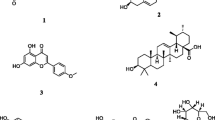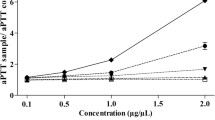Abstract
Pine needle extract (PE) and fermented pine needle extract (FPE) have been reported to show various biological and pharmacological activities such as antioxidant, anti-inflammatory, anti-bacterial, anti-cholesterol, gastrointestinal motility control, and fibrinolytic effect. The aims of our research were to isolate fibrinolytic compounds from PE and FPE and evaluate their antithrombotic activity in vitro and in vivo. Protocatechuic (1) and shikimic (2) acids were isolated and identified from FPE. 1 and 2 not only have fibrinolysis activity but also inhibit fibrin formation similar to aspirin. Lysis of fibrin clots by 1 and 2 occurred completely at pH 2–4. Results of SDS-PAGE showed that fibrin polypeptide chains (Aα, Bβ, γ) lysed by 1 and 2 were intact. The antithrombotic effects of 1 and 2 were confirmed by models of carrageenan-induced tail thrombosis, collagen and epinephrine-induced pulmonary thromboembolism in mice, and FeCl3-induced carotid arterial thrombus. Moreover, 1 and 2 did not induce hemorrhage in the tail veins of mice, unlike common antithrombotic compounds. We also measured changes in the quantities of 1 and 2 obtained from FPE. As fermentation progressed, we demonstrated that the quantity of 1 steadily increased, while the quantity of 2 did not significantly change. We therefore demonstrated that FPE is an excellent resource for 1 and 2 and can be produced inexpensively in sufficient quantities for industrial-scale extraction.









Similar content being viewed by others
References
Mine Y, Wong AHK, Jiang B (2005) Fibrinolytic enzymes in Asian traditional fermented foods. Food Res Int 38:243–250
Mihara H, Sumi H, Yoneta T, Mizumoto H, Ikeda R, Seiki M, Maruyama M (1990) A novel fibrinolytic enzyme extracted from the earthworm, Lumbricus rubellus. Jpn J Physiol 41:461–472
Jia YH, Jin Y, Lü QM, Li DS, Wang WY, Xiong YL (2003) Jerdonase, a novel serine protease with kinin-releasing and fibrinogenolytic activity from Trimeresurus jerdonii venom. Acta Biochim Biophys Sinica 35:689–694
Ahn MY, Hahn BS, Ryu KS, Kim JW, Kim I, Kim YS (2003) Purification and characterization of a serine protease with fibrinolytic activity from the dung beetles, Catharsius molossus. Thromb Res 112:339–347
Lee JS, Bai HS, Park SS (2006) Purification and characterization of two novel fibrinolytic proteases from mushroom, Fomitella fraxinea. J Microbiol Biotechnol 16:264–271
Sumi H, Nakajima N, Mihara H (1992) Fibrinolysis relating substances in marine creatures. Comp Biochem Physiol B 102:163–167
Jeong YK, Park JU, Baek H, Park SH, Kong IS, Kim DW, Joo WH (2001) Purification and biochemical characterization of a fibrinolytic enzyme from Bacillus subtilis BK-17. World J Microb Biot 17:89–92
Patrono C, García Rodríguez LA, Landolfi R, Baigent C (2005) Low-dose aspirin for the prevention of atherothrombosis. N Engl J Med 353:2373–2383
Caboun V (2006) Tree-tree allelopathic interactions in middle European Forests. Allelopathy J 17:17–31
Kim KY, Chung HJ (2000) Flavor compounds of pine sprout tea and pine needle tea. J Agric Food Chem 48:1269–1272
Choi EM (2007) Antinociceptive and antiinflammatory activities of pine (Pinus densiflora) pollen extract. Phytother Res 21:471–475
Jung MJ, Chung HY, Choi JH, Choi JS (2003) Antioxidant principles from the needles of red pine, Pinus densiflora. Phytother Res 17:1064–1068
Park GY, Paudyal DP, Hwang ID, Tripathi GR, Yang YK, Cheong HS (2008) Production of fermented needle extracts from red pine and their functional characterization. Biotechnol Bioprocess Eng 13:256–261
Park GY, Paudyal DP, Park YM, Lee CS, Hwang ID, Tripathi GR, Cheong HS (2008) Effects of pine needle extracts on plasma cholesterol, fibrinolysis and gastrointestinal motility. Biotechnol Bioprocess Eng 13:262–268
Carr ME, Hermans J (1978) Size and density of fibrin fibers from turbidity. Macromolecules 11:46–50
Hagimori M, Kamiya S, Yamaquchi Y, Arakawa M (2009) Improving frequency of thrombosis by altering blood flow in the carrageenan-induced rat tail thrombosis model. Pharmacol Res 60:320–323
Kim KY, Bae ON, Lim KM, Noh JY, Sj Kang, Chung KY, Chung JH (2012) Novel antiplatelet activity of protocatechuic acid through the inhibition of high shear stree-inuced platelet aggregation. J Pharmacol Exp Ther 343:704–711
Chelucci RC, Dutra LA, Lopes Pires ME, de Melo TR, Bosquesi PL, Chung MC, Dos Santos JL (2014) Antiplatelet and antithrombotic activities of non-steroidal anti-inflammatory drugs containing an N-acyl hydrazone subunit. Molecules 19:2089–2099
DiMinno G, Silver MJ (1983) Mouse antithrombotic assay: a simple method for the evaluation of antithrombotic agents in vivo. Potentiation of antithrombotic activity by ethyl alcohol. J Pharmacol Exp Ther 225:57–60
Wang F, Wang C, Li M, Zhang JP, Gui LL, An XM, Chang WR (2005) Crystal structure of earthworm fibrinolytic enzyme component B: a novel, glycosylated two-chained trypsin. J Mol Biol 348:671–685
Wideing JU, Eisinger G, Kostering HJ (1989) Determination of soluble fibrin by turbidimetry of its protamine sulphate-induced paracoagulation. J Clin Chem Clin Biochem 27:57–64
Thorsen S (1992) The mechanism of plasminogen activation and the variability of the fibrin effector during tissue type plasminogen activator—mediated fibrinolysis. Ann N Y Acad Sci 667:52–63
Izzo SV, Schwartz ML, Hill RL, McKee PA (1972) The effect of plasmin on the subunit structure of human fibrinogen. J Biol Chem 247:636–645
Lord ST (2011) Molecular mechanisms affecting fibrin structure and stability. Arterioscler Thromb Vasc Biol 31:494–499
Antovic A, Perneby C, Ekman GJ, Wallen HN, Hjemdahl P, Blombäck M, He S (2005) Marked increase of fibrin gel permeability with very low dose ASA treatment. Thromb Res 116:509–517
Fatah K, Beving H, Albåge A, Ivert T, Blombäck M (1996) Acetylsalicylic acid may protect the patient by increasing fibrin gel porosity. Is withdrawing of treatment harmful to the patient? Eur Heart J 17:1362–1366
Williams S, Fatah K, Hjemdahl P, Blombäck M (1998) Better increase in fibrin gel porosity by low dose than intermediate dose acetylsalicylic acid. Eur Heart J 19:1666–1672
Shulman S, Katz S, Ferry JD (1953) The conversion of fibrinogen to fibrin. XII. Influence of pH, ionic strength and hexamethylene glycol concentration on the polymerization of fibrinogen. Arch Biochem Biophys 42:245–256
Fersht A (1999) Structure and mechanism in protein science: a guide to enzyme catalysis and protein folding. W.H. Freeman, New York, pp 324–375
Barrero AF, Oltra JE, Poyatos JA (1996) Acidic metabolites from Phycomyces blakesleeanus. Phytochemistry 42:1427–1433
Sui R (2008) Separation of shikimic acid from pine needles. Chem Eng Technol 31:469–473
Acknowledgments
This study was supported by research Fund from Chosun University, 2015.
Author information
Authors and Affiliations
Corresponding author
Electronic supplementary material
Below is the link to the electronic supplementary material.
Rights and permissions
About this article
Cite this article
Park, J., Lee, B., Choi, H. et al. Antithrombosis activity of protocatechuic and shikimic acids from functional plant Pinus densiflora Sieb. et Zucc needles. J Nat Med 70, 492–501 (2016). https://doi.org/10.1007/s11418-015-0956-y
Received:
Accepted:
Published:
Issue Date:
DOI: https://doi.org/10.1007/s11418-015-0956-y




